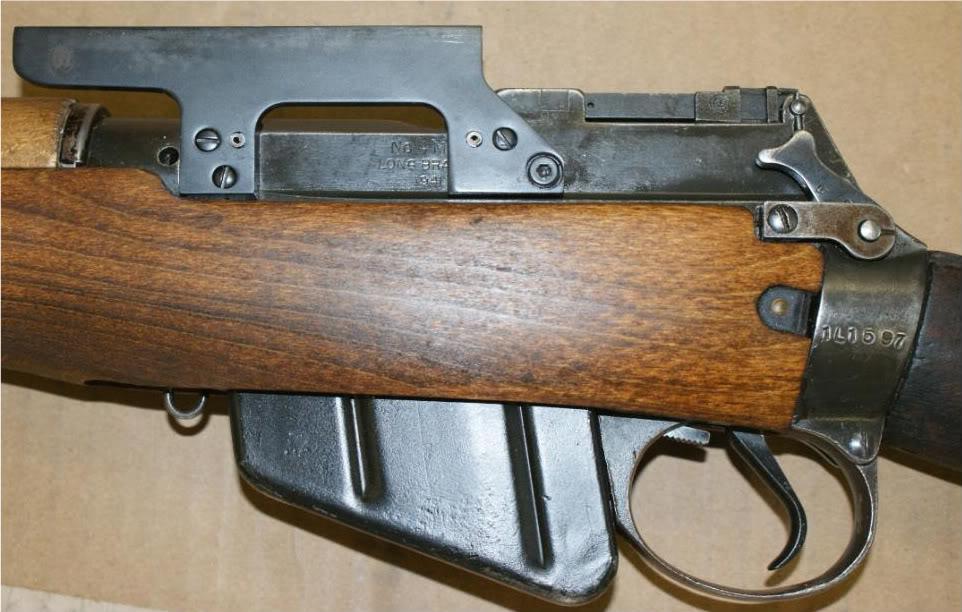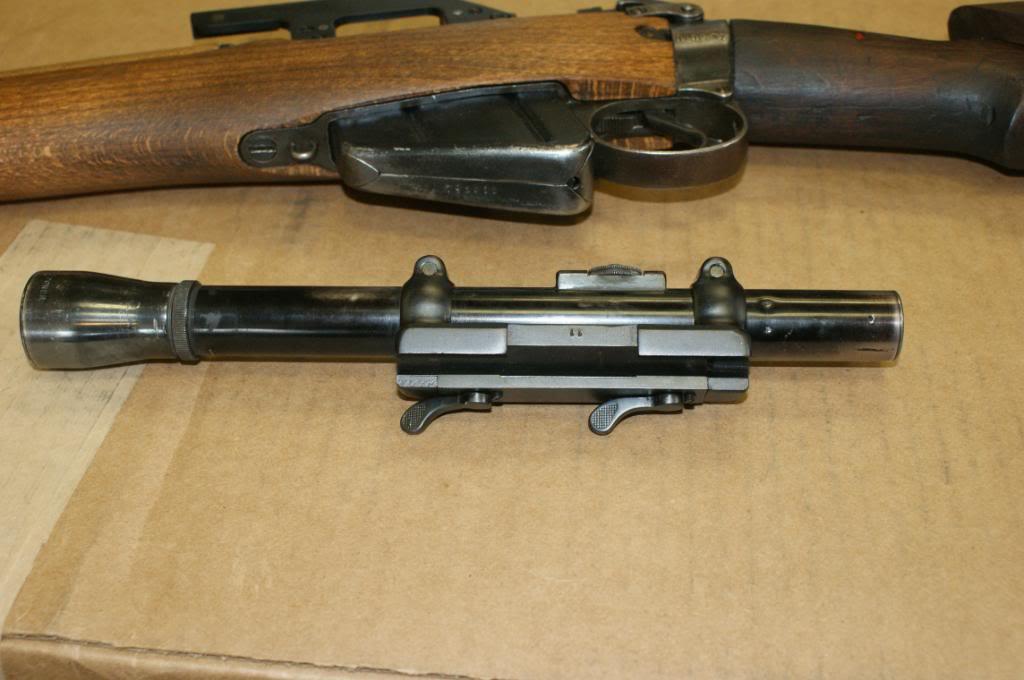-
FREE MEMBER
NO Posting or PM's Allowed

No4 T telescope
Good morning. I have a nice repro ofa No.32 Mk II scope, lens are clear and all goes well . No.32 scope were the only used in No.4 rifle ? Did they usea weaver k 2,5 a lyman alaskan a weaver k4 or something else? I'm searching a less expensive scope but still historically correct.
Information
 |
Warning: This is a relatively older thread
This discussion is older than 360 days. Some information contained in it may no longer be current. |
|
-
12-17-2012 05:04 AM
# ADS
Friends and Sponsors

-
You are stuck with the No.32 scope of some sort unless you get really obscure and go Canadian ! Different mounting system used for the Lyman scopes, though. Never mind the C No.67 scope.
! Different mounting system used for the Lyman scopes, though. Never mind the C No.67 scope.
-
Thank You to jmoore For This Useful Post:
-
Legacy Member

Bow: As Jmoore says, the Canadians used a variety of mounts and actually did mount Lyman Alaskans (7/8inch tube) in the more common British mount/bracket with "bushings" (see picture on pg. 40 of "Without Warning" by Clive Law. Not being a machinist I have no idea how difficult it would be to make a facsimile of those bushings. I use a one inch Weaver on my "replica" 4T but also have a replica #32 to make it look more accurate.
mount/bracket with "bushings" (see picture on pg. 40 of "Without Warning" by Clive Law. Not being a machinist I have no idea how difficult it would be to make a facsimile of those bushings. I use a one inch Weaver on my "replica" 4T but also have a replica #32 to make it look more accurate.
Ridolpho
-
Thank You to Ridolpho For This Useful Post:
-
Advisory Panel



Originally Posted by
Ridolpho

Bow: As Jmoore says, the Canadians used a variety of mounts and actually did mount Lyman Alaskans (7/8inch tube) in the more common
British
mount/bracket with "bushings" (see picture on pg. 40 of "Without Warning" by Clive Law. Not being a machinist I have no idea how difficult it would be to make a facsimile of those bushings. I use a one inch Weaver on my "replica" 4T but also have a replica #32 to make it look more accurate.
Ridolpho
One rifle was "bushed" with the 7/8" Lyman Alaskan, and one was "bushed" with a 3/4" Weaver. Both rifles were returned to LB after trials for installation of the conventional No32 scopes.
-
The Following 2 Members Say Thank You to Lee Enfield For This Useful Post:
-
I always had the gravest doubts about these telescope 'bushing' trials, especially within a standard mount. It was doomed to fail and that would have been as plain for all to see as the nose on your face. I said it when I first read it and read it again open mouthed!
The taper-lock cradle screws can only be locked until the taper binds and this was just sufficient to ensure that you could not ever exert sufficient torque to crush the telescope tube - even slightly. The tube was retained fore and aft by the segment cover rings and the turret and against rotation by the stop screw. On the other hand, the others had none of these and unless you could clamp the telescope down with sufficient loading to prevent this, it WOULD fail. It is really simple school boy mechanics.
So even given bushed split-rings to clamp it into the No32 bracket, the very limited torque you can impart onto the taper-lock screws, the telescope WOULD move. You see it all the time. Call me an old cynic, but even the poorest engineer at LB would have known this and I'd say that unless anyone comes up with paperwork to substantiate this doomed to fail at the outset 'trial', then I suspect that these bushed rinmgs are a post war idea from someone that's been accepted as fact.
Just my bleedin' obvious been doin' it a long time take on things - that I am apt to do when the need arises
Last edited by Peter Laidler; 12-18-2012 at 04:16 AM.
-
The Following 2 Members Say Thank You to Peter Laidler For This Useful Post:
-
Advisory Panel


I always had the gravest doubts about these telescope 'bushing' trials, especially within a standard mount. It was doomed to fail and that would have been as plain for all to see as the nose on your face. I said it when I first read it and read it again open mouthed!
The taper-lock cradle screws can only be locked until the taper binds and this was just sufficient to ensure that you could not ever exert sufficient torque to crush the telescope tube - even slightly. The tube was retained fore and aft by the segment cover rings and the turret and against rotation by the stop screw. On the other hand, the others had none of these and unless you could clamp the telescope down with sufficient loading to prevent this, it WOULD fail. It is really simple school boy mechanics.
So even given bushed split-rings to clamp it into the No32 bracket, the very limited torque you can impart onto the taper-lock screws, the telescope WOULD move. You see it all the time. Call me an old cynic, but even the poorest engineer at LB would have known this and I'd say that unless anyone comes up with paperwork to substantiate this doomed to fail at the outset 'trial', then I suspect that these bushed rinmgs are a post war idea from someone that's been accepted as fact.
Just my bleedin' obvious been doin' it a long time take on things - that I am apt to do when the need arises
Well the war-time trial reports and instructions to return the rifles after completion to the officer who dispatched them to the trials are excerpted in the neat little book called "without warning". There are contemporary? photos of the bushings which were used on the Lyman Alaskan scope, which was reported to have light gathering abilities superior to the comtemporary No32 scope.
Without referring to the book, I believe that you are correct in pointing out that the bushed mounts were rejected as a solution, along with the Weaver scope.
-
-
Advisory Panel


To the OP: a few years ago someone in Italy was making some very nice replicas of the SAL "Griffen & Howe" type mount. They were sold on eBay at the time. Unfortunately I didn't save any of the details. Maybe someone else will remember?
was making some very nice replicas of the SAL "Griffen & Howe" type mount. They were sold on eBay at the time. Unfortunately I didn't save any of the details. Maybe someone else will remember?
“There are invisible rulers who control the destinies of millions. It is not generally realized to what extent the words and actions of our most influential public men are dictated by shrewd persons operating behind the scenes.”
Edward Bernays, 1928
Much changes, much remains the same. 
-
-

Originally Posted by
Surpmil

replicas of the SAL "Griffen & Howe" type mount


Not mine, old photos of "new production mounts" as mentioned above.
-
Thank You to jmoore For This Useful Post:
-
FREE MEMBER
NO Posting or PM's Allowed


Originally Posted by
Surpmil

To the OP: a few years ago someone in
Italy
was making some very nice replicas of the SAL "Griffen & Howe" type mount. They were sold on eBay at the time. Unfortunately I didn't save any of the details. Maybe someone else will remember?
Yes! a good man on ebay steel produce and sell this Griffin&howe, with correct taps and scews. It's not too expensive. But what is his value? was it ever used on true sniper rifles?
-
Advisory Panel


That is actually not the variety of mount and base I saw on eBay. I believe it was the later type used with the C67 scope.
Interesting to see the 1L1597 number on a 1941 marked action. I assume it is a MkI*?
I've got a 1L520- action downstairs and it is a 1942 MkI*.
Bow, the mount that jmoore shows was used on Canadian sniper rifles.
sniper rifles.
“There are invisible rulers who control the destinies of millions. It is not generally realized to what extent the words and actions of our most influential public men are dictated by shrewd persons operating behind the scenes.”
Edward Bernays, 1928
Much changes, much remains the same. 
-
Thank You to Surpmil For This Useful Post:















 Register To Reply
Register To Reply















